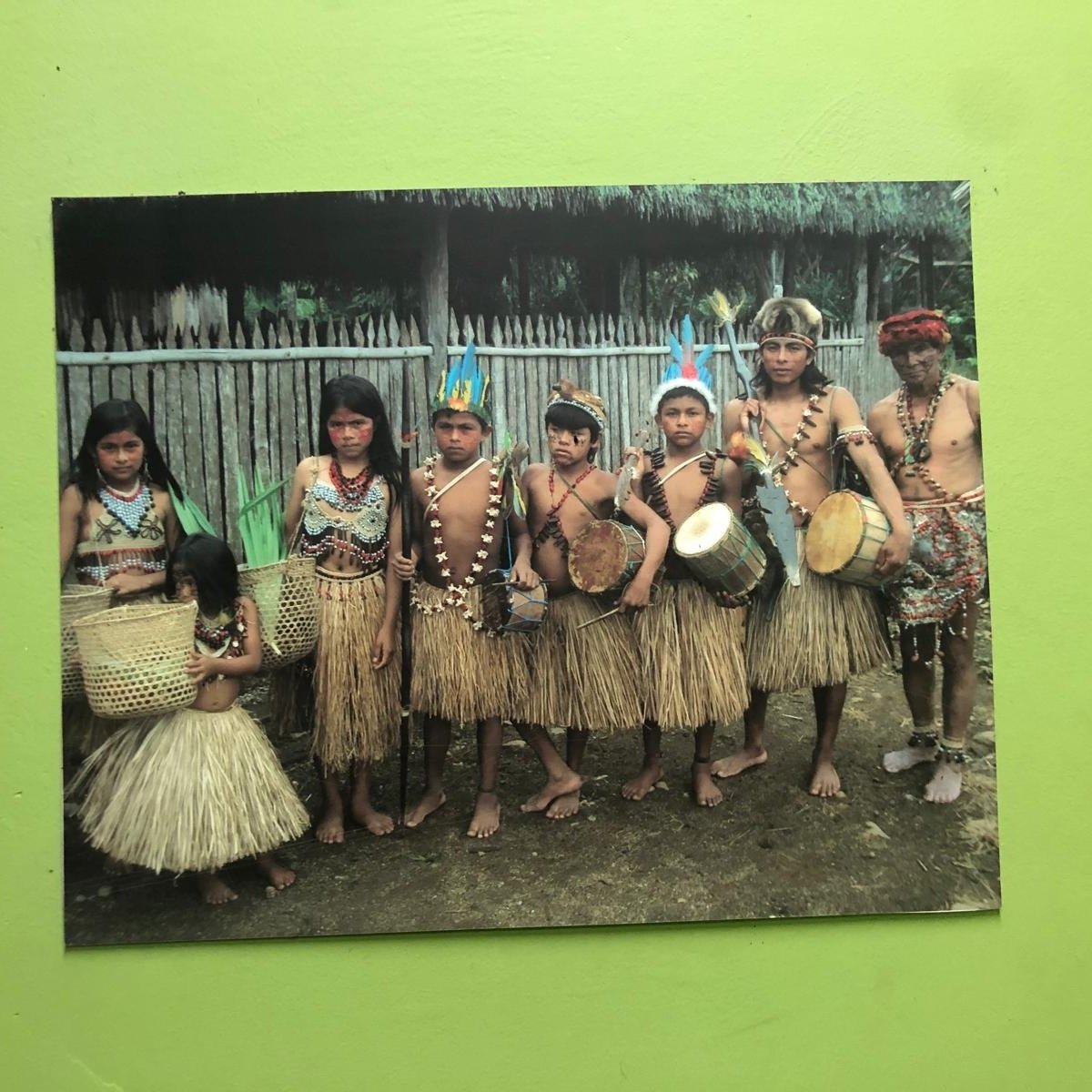Pastaza Province in the Amazonas Ecuador: Communities, Tribes and Culture.
Noy with the chief hat in the community of the Amazon of Ecuador.
Visiting the Amazonas Ecuador was definitely the highlight of my recent trip to South America. The main principles, in my eyes, are to co-mingle with the locals, and be familiar with their culture, authenticity, and sustainable way of living.
The Ecuadorian Amazon Tribe “Achuar” in their traditional face tattoo and jewelry as demonstrated from the ‘Mapa Etnico de Pastaza’ in the “MEMPA” Museum.
The Amazonas Ecuador is rich with culture, communities, and tribes. Knowing the different tribes, who are living in different areas of the Amazons is important for the local heritage and continuous of tribunal way of living.
A whole tribe of the “Shuar” in Ecuador Amazon as demonstrated from the ‘Mapa Etnico de Pastaza’ in the “MEMPA” Museum.
I have been visiting the national museum, “Museo Etno-Arquelogico Municipal de Pastaza”, “MEMPA” in Puyo, Amazonas, Ecuador. I learned that in the Amazon in Ecuador there are different tribes for different regions. Each tribe is custom with specific tattoos, rituals, customs, gastronom, and shamanic rituals. In the province of Pastaza, where I have been visiting, there are a few tribes. The tribe of Kichwa, Shuar, Achuar, Sapara, Shiwiar, Andwa y Waodani. The tribes are using the shamanic ceremonies and herbs, such as Ayahuasca, Tobacco, Palo Santo and additional other herbal medicines.
Exhibition from the “MEMPA” “Museo Etno-Arquelogico Municipal de Pastaza”.
Man from the “Shiwiar” Tribe in the Amazon of Ecuador as demonstrated from the ‘Mapa Etnico de Pastaza’ in the “MEMPA” museum.
Each tribe is living in a different area of the Pastaza province. They have their specific language, the way that their society is organized, their celebrations, their food and their costumes of dress. In the museum, you can witness the differences of the tribes in all of these categories. The museum has demonstrations of old costumes, ancient pottery and visualization of flora and plants of the region.
Exhibition of different animals typical in the Amazon of Ecuador including snakes, caiman, tiger skin and shell. Demonstration in the “MEMPA” museum in Puyo, Ecuador.
Exhibition of the traditional shamanic ceremonies and tools in the tribes of the Amazonas in Ecuador. Demonstration from the “MEMPA” museum.
Demonstration of Eagle feathers in the Amazonas as placed in the “MEMPA” museum.
Noy on the way to the communities of the Amazon in Ecuador.
Traveling in the region of Pastaza, we have decided to visit a few communities including the Sacha Wasi and Wayuri Community. We crossed the bridge across the Puyo river in order to get to the communities. The communities in that area are very welcoming to local tourists. In order to get there, you need to come with a local guide. We were lucky to be invited without a local guide due to the fact that we speak Spanish and we spent a lot of time in the Amazon area.
Carmit crossing the bridge to enter the communities of the region in the Amazon of Ecuador.
Our hellos to the family monkey of the Wayuri community in the Amazon of Ecuador.
Greeting us, the typical parrot in the Amazon of Ecuador.
We were welcomed by the families and the animals who are co-living together in the communities. Among those animals we were introduced to the monkeys, the parrots and the other special birds of the Amazon. The family living in the community welcomed us with a “chicha of yucca” drink that was made by the head of the family. They were very happy to prepare the “chicha of yucca” and to share it with us, the knowledge of preparation and demonstration of the process.
The head of the family in the Amazonas community offering “chicha of yucca” as a welcome drink.
“Chica of yucca” drink from a special, hand-made cup from the Amazonas fruit.
Traditional house in the community of Wayuri in the Amazon of Ecuador.
We toured the community, which is deep in the jungle. We saw the community's private and common area, including the cabins where the families sleep, the Maloka where the families gather together, the kitchen area, in a specific structure, and the canoe area on the river.
Carmit with the children of the community walking along the Puyo River bank in the Amazon of Ecuador.
Noy next to the Puyo River in the Amazon of Ecuador.
We had the children of the village walking us to the river. We continued with the tour to the artisanal shop of the community, where you can purchase all of the hand-made jewelry and pottery made by the community. The people are very proud of their artisanal and with their generosity and our money, we got a few souvenirs. At the end of the visit, we were greeted once again by the monkey who lives with the family in the community.
Artisinal shop in the community of the Amazon of Ecuador.
Carmit with the family monkey of the Wayuri community in the Amazon of Ecuador.
Noy with the family monkey of the Wayuri community in the Amazon of Ecuador.
After visiting the communities, we continued to explore the area of other local communities of the Amazonas in Ecuador. In the evening, we made a fire and cooked the platanos that we picked from the land. We sat with our hosts near the fire in the evening and enjoyed the atmosphere of the jungle. We enjoyed our day exploring the communities and area of the Amazonas, Ecuador.
The local store “Tienda Carmita” near the Cascada “Holy Vida” in the Amazon of Ecuador.
Evening next to the fire, cooking platano in the Amazon of Ecuador.
In our next blog, we will share the knowledge of other communities in the Amazon of Ecuador.
Traditional woman from the tribe of “Kichwa” in the Amazon of Ecuador as demonstrated from the ‘Mapa Etnico de Pastaza’ in the “MEMPA” Museum.























